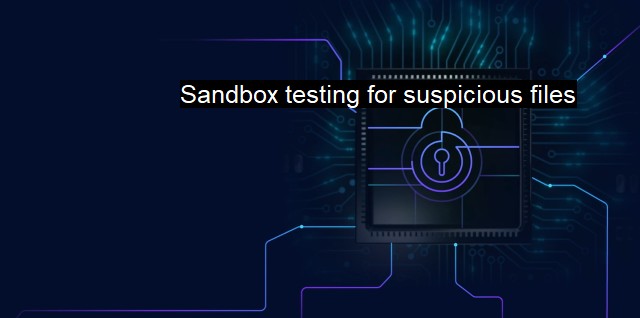What are Sandbox testing for suspicious files?
Why Sandbox Testing is Crucial for Modern Cybersecurity: Understanding the Virtual Space of Software and Hardware Simulation
Sandbox testing for suspicious files is a crucial aspect of modern cybersecurity measures and part of the fighting mechanisms in antivirus software. It represents an isolated environment created to execute and assess potentially hazardous software code without endangering the host system. The fundamental idea revolves around creating an isolated, controlled virtual space, replicating a full production environment for the execution of unknown or suspicious files.Sandboxing means setting boundaries around code execution areas constrained by special permissions, thus sealing them off from more sensitive parts of the system. It's an effective strategy for reducing vulnerability to malicious programs such as malware and viruses. Here's how it works; when an antivirus detects a suspicious file, instead of running it immediately in the primary system, it's introduced into the sandbox environment for observation.
This function in sandboxing encompasses two main steps; execution and observation. While rendering the code in a safeguarded environment, the sandbox simultaneously monitors the behavior of the file; changes it makes, hooks it sets, networks it communicates with, registries it edits, or any unusual activities. Post-analysis, if the file questions security regulation or shows malicious activity, the antivirus software can safely neutralize it without causing harm to the primary system. Conclusively this enables malwares detection before infection spreads in the user environment.
Sandbox testing doesn't just identify malware based on known patterns (signature-based detection), it also discovers previously unidentified threats by recognizing malicious behavior (heuristics-based detection). This is especially critical in today's rapidly evolving technology realm where cybercriminals continually develop insidious ways to hack systems.
It’s important to acknowledge that before sandboxing, antiviruses defended systems relatively cautiously; exclusively detecting and eliminating infringements immediately. this traditional, reactive method became insufficient as cyber threats grew in sophistication, demanding more proactive and dynamic approaches. Hackers would recompile, rewrite, or just insert little changes to dodge predetermined controls. This urging issue ramped up the need to cover this gap, thus the instigation and wide application of sandbox testing.
The effectiveness of a sandbox remarkably depends on its resemblance to the system it aims to secure. For instance, if there can be an exact mirror of the sensitive system that can capture interferences in a life-like manner, unveiling hacker's intentions & script becomes easier. So, perfect sandboxing involves creating an authentic simulation in the sandbox environment. In reality, since every process has resource and coding limitations, developing the perfect sandbox is expensive and technically advanced.
Of course, the sandboxing process is not devoid of challenges. Advanced malwares can lay dormant or avoid executing any harmful operations until they have escaped the sandbox, making evasion a tangible issue. Similarly, surrounding resource-taxing and time-consuming inconveniences might discourage application. false positives have the tendency to create further complications within the purview of sandbox testing.
Regardless of the evident challenges, sandbox testing is fundamentally principal to fight against the overwhelmingly growing cyber threats. Not applying the sandbox concept can lead to enormously costly infractions, stealth information thefts, hacking attempts, and corrupting crucial datasets, causing tremendous expenses and damage for organizations and individuals. It is therefore fitting to invest in the secure barriers provided by sandbox testing, since the risks of abstaining can significantly imperil system security.
Sandbox testing for suspicious files forms the cornerstone of current cybersecurity structure. Its function, combining execution and observation in a secure environment is indispensable in reducing the risk of propagating malicious software. Even though cyber threats continue to arise and evolve with tremendous speed, investment in smart cyber defense systems like sandbox testing continues to be an effective strategy, deserving a central place in our wider endeavor towards maintaining cyber security globally.

Sandbox testing for suspicious files FAQs
What is sandbox testing for suspicious files?
Sandbox testing is a type of cybersecurity testing that involves running suspicious files in a virtual environment to analyze their behavior and determine if they are malicious. It is often used by antivirus software to detect and analyze viruses, Trojans, and other types of malware.How does sandbox testing work?
Sandbox testing works by creating a virtual environment in which suspicious files can be run and analyzed without affecting the underlying system. This allows analysts to observe the behavior of the file and determine if it is malicious, without risking damage to the system.What are the benefits of sandbox testing for suspicious files?
Sandbox testing provides several benefits for cybersecurity and antivirus protection. It allows analysts to quickly identify and isolate potentially malicious files, reducing the risk of damage to the system. It also provides a safe environment for testing and analyzing new threats, allowing for more effective protection against evolving threats.Can sandbox testing guarantee 100% protection against malware?
While sandbox testing is an effective tool for identifying potential threats, it cannot guarantee 100% protection against malware. New threats and variations on existing threats are constantly being developed, and it can be difficult to detect and analyze them all. However, sandbox testing is a crucial part of a comprehensive cybersecurity strategy and can significantly reduce the risk of infections and data breaches.| | A | | | B | | | C | | | D | | | E | | | F | | | G | | | H | | | I | | | J | | | K | | | L | | | M | |
| | N | | | O | | | P | | | Q | | | R | | | S | | | T | | | U | | | V | | | W | | | X | | | Y | | | Z | |
| | 1 | | | 2 | | | 3 | | | 4 | | | 7 | | | 8 | | |||||||